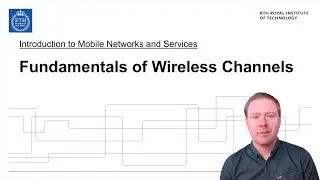Wireless Networks With Uniform Performance: Distributed MIMO and Sequential Fronthaul
This is a keynote recording from the IEEE SmartNets 2022 conference (https://smartnets.ieee.tn). Professor Emil Björnson at the KTH Royal Institute of Technology is presenting on the topic "Wireless Networks With Uniform Performance: Distributed MIMO and Sequential Fronthaul"
Abstract: The peak performance in wireless networks has grown over the last decades. In current 5G deployments, the spectral efficiency improvements are mainly thanks to the Massive MIMO technology. This means that the base station consists of arrays with around 64 antenna-integrated radios, which are utilized to focus each signal at its desired receiving user and transmit it to multiple users simultaneously. This is just the beginning of the MIMO (multiple-input, multiple-output) story. As the data traffic increases, we can continue adding more antennas to the base station arrays to support more users, but the users will always observe large data rate variations depending on their location in the cell due to distance-based pathloss and inter-cell interference.
In this keynote, we will consider an alternative approach for future networks: serve the users by antennas that are distributed over the coverage area. By shifting from a world where base stations are surrounded by users, to a world where each user is surrounded by antennas, we can deliver almost uniformly good spectral efficiency wherever the user is. This concept has recently been called Cell-Free Massive MIMO but has its roots in earlier concepts for base station cooperation. A core practical challenge is to deploy a massively distributed MIMO array affordably. One potential approach is to use radio stripes, which are cables with integrated antennas. We will take a close look at how these can be implemented and recent results on how communications algorithms can be designed to exploit their special characteristics.
The slides can be downloaded here: https://github.com/emilbjornson/prese...
#6g #mimo #wireless #communication #cellfree #cellular #5g #fronthaul #networks












![Bit Error Ratio or Channel Capacity: Which metric should I use? [Frequently Asked Questions]](https://images.videosashka.com/watch/sK537pnqjWM)
![Ep 40. Synchronization of Massive Antenna Arrays [Wireless Future Podcast]](https://images.videosashka.com/watch/dS4E5Jy7DQk)

![Ep 39. Radio Stripes at Terahertz (With Parisa Aghdam) [Wireless Future Podcast]](https://images.videosashka.com/watch/BvWAtb9gpAU)
![How many beams can you send from a MIMO array? [Frequently Asked Questions]](https://images.videosashka.com/watch/tXDN4BFSSnI)
![Ep 38. Things We Learned at the 6G Symposium [Wireless Future Podcast]](https://images.videosashka.com/watch/j0HOLZjGRUQ)
![Ep 37. Wireless Future Panel Discussion (Live Podcast) [Wireless Future Podcast]](https://images.videosashka.com/watch/PX23UWSFzSU)

![6G kräver många fler antenner än idag - så ska det gå till! [English version exists]](https://images.videosashka.com/watch/HJMYruMz46Y)


![Ep 36. 6G from an Operator Perspective [Wireless Future Podcast]](https://images.videosashka.com/watch/odqBsaSBo-4)
![Beamwidth, beam pattern, and sensing [Part 5, Fundamentals of mmWave communication]](https://images.videosashka.com/watch/UbA4IbFXTSU)
![Maximum ratio and zero-forcing beamforming [Part 4, Fundamentals of mmWave communication]](https://images.videosashka.com/watch/w46c0QhByPg)
![Constructive and destructive interference [Part 3, Fundamentals of mmWave communication]](https://images.videosashka.com/watch/hxkojUEKAR0)
![Wireless propagation losses [Part 2, Fundamentals of mmWave communication]](https://images.videosashka.com/watch/H7Vh-7kiejQ)
![Beamforming directivity [Part 1, Fundamentals of mmWave communication]](https://images.videosashka.com/watch/WOE_nKBKUsE)
![Ep 35. Ten Challenges on the Road to 6G [Wireless Future Podcast]](https://images.videosashka.com/watch/t4W4OEPtsuQ)

![Ep 34. How to Achieve 1 Terabit/s over Wireless? [Wireless Future Podcast]](https://images.videosashka.com/watch/Zb0nHvR_TB4)